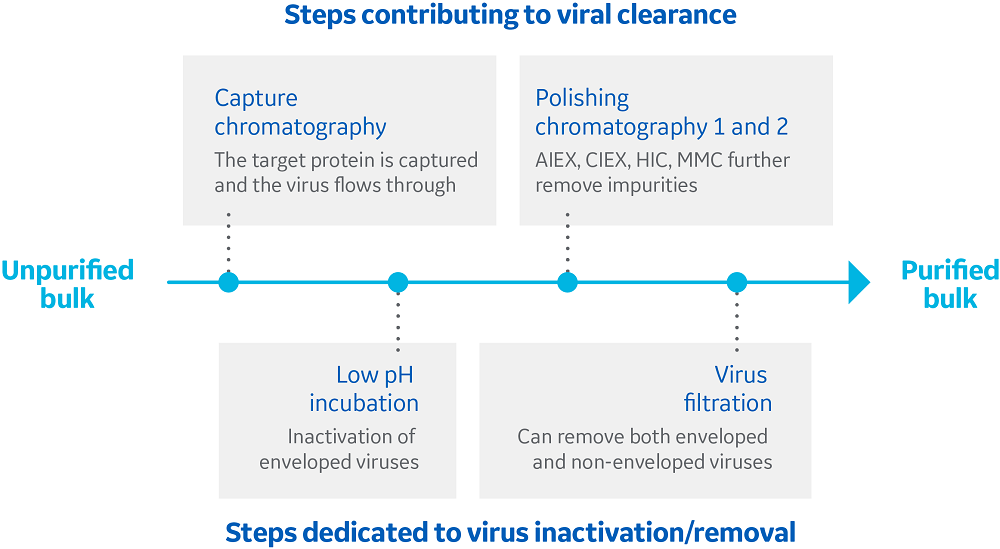Effective viral clearance studies remain one of the challenges facing manufacturers of biologics. These studies are an essential part of process validation and are critical to ensure drug safety. This article provides the basics of what you need to know when studying virus reduction of a chromatography step.
Several bioprocess steps contribute to viral clearance
To asses viral safety when validating a biomanufacturing process, you should study any step you claim to be reducing virus load. This assessment is usually done through a viral clearance study.
The results of the study are used as indirect evidence that the process can inactivate or remove viral contamination. Two types of biomanufacturing steps can provide viral reduction (Fig 1):
- Steps dedicated to virus inactivation or removal, such as pH treatment and heat treatment
- Steps contributing to viral clearance, such as chromatography steps dedicated to purifying the product, but with a potential to provide viral reduction
Fig 1. Overview of the typical steps that provide viral reduction in a downstream monoclonal antibody (mAb) manufacturing process.
Typical workflow for studying viral clearance of a chromatography step
Ensuring viral clearance is critical when designing a new process, when parameters are changed in an existing process, and at different stages of clinical trials. You should also ensure viral clearance when source materials, such as cell lines and growth factors, are changing (1).
The virus clearance study itself is quite straightforward. You spike the sample load with virus, run the chromatography step on a scale-down column, and document the ability to clear the spiked virus (Fig 2).
Fig 2.Simplified workflow for a viral clearance study of a chromatography step.
Viral clearance is defined as the difference between the total virus amount in the input sample and the product-containing fraction after purification. The viral reduction capability is often referred to as the log reduction value (LRV) of a process step (2). The total clearance capability of the process is the result of the viral reduction of all unit operations used.
Demands vary for different processes and products
When filing claims for viral clearance, you must define the unit operations used in the process steps that reduce viral contamination. The justification for, and the extent of, the required validation studies for these units are reviewed on a case-by-case basis as it varies depending on the manufacturing process and the type of product.
What is considered as sufficient viral clearance depends on the starting material, product indications, patient population, and dosage. A safety margin is calculated for each step and the minimal viral clearance required for each step must be documented.
Chromatography techniques contributing to viral clearance
Some of the most common chromatography steps can contribute to virus clearance. Examples are flow-through steps using anion exchange (AIEX) and multimodal AIEX chromatography. These techniques can offer log reductions in the size of 4 to 5 logs. Hydrophobic interaction chromatography (HIC) can often provide reductions in the same range (3).
Multimodal AIEX resins often display a high and robust viral clearance in a very broad pH and conductivity window (3). This is one of the reasons why you find this resin type included in many purification platforms.
Cation exchange (CIEX) and capture steps, like protein A affinity, also contribute to viral reduction. However, these techniques generally offer reductions in the size of 2 to 3 logs (2). Table 1 summarizes typical log reduction values for different chromatography techniques.
Table 1. Typical viral reductions observed for different chromatography techniques used in purification processes.
| Chromatography steps | Typical viral reduction (log10) |
| Affinity chromatography | 2 to 3 |
| AIEX | 4 to 5 |
| CIEX | 2 to 3 |
| HIC | 4 to 5 |
| Multimodal AIEX | 4 to 5 |
Conditions for scale-down studies
To demonstrate the minimal viral reduction a specific process step can provide, you often test the worst-case conditions.
Several critical variables affect viral clearance in chromatographic processes. These include studying the extremes of conditions such as pH, flow rates, and protein load. Changing these conditions give an indication of the viral reduction capabilities of the process.
For example, in the capture step of a mAb, the virus might interact with the target molecule and/or the chromatography resin. To analyze these interactions and to study viral reduction, you should vary process conditions in a relevant way.
Use a scale-down column format for viral clearance studies
Viral clearance studies are usually performed using a scale-down model. For example, you can use a small-scale chromatography column to mimic a large-scale step if the same bed height and flow velocity are used (Fig 3).
Fig 3. Illustration of how a small-scale chromatography column can be used in viral clearance scale-down studies.
Want to learn more?
- Read this blog post for tips on what to consider for chromatography scale-down studies.
- Read this article to help determine if you should be using prepacked columns or packing your own for viral clearance studies
References
- Jagschies, G. et al. Biopharmaceutical processing: Development, design and implementation of manufacturing processes, Elsevier, Edition 1, p. 1085–1087 (2017)
- Ruppach, H. Log10 Reduction Factors in Viral Clearance Studies, BioProcess. J., 12(4), 24–30 [Online] https://www.bioprocessingjournal.com/ (7 January 2014 posting date)
- Brown, M. R. et al. A step-wise approach to define binding mechanisms of surrogate viral particles to multi-modal anion exchange resin in a single rel="noopener noreferrer" solute system. Biotechnol. Bioeng., 114(7), p. 1487–1494 (2017)


